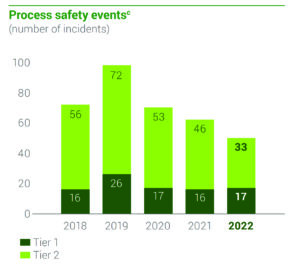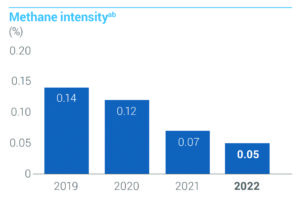

BP reaffirms 2050 net-zero commitment in newest sustainability report but scales back interim goals
BP issued its 2022 sustainability report showcasing progress made against its ESG-related goals.
Against its aim to be net-zero across its entire operations by 2050, the company has cut Scope 1 and 2 absolute emissions by 41% compared with 2019.
Against its aim to be net-zero across its upstream oil and gas operations by 2050, which is BP’s Scope 3 aim, the company said it has reduced absolute emissions from the carbon from upstream oil and gas production by 15% since 2019. BP recently adjusted its progress goals for net-zero production, now targeting a 10-15% reduction by 2025 instead of 20%, and targeting 20-30% reduction by 2030 instead of 35-40%.

BP also said it expects to produce approximately 2 million bbl of oil equivalent a day by 2030, which would be 25% lower than in 2019. This takes into account anticipated decline of existing fields, new projects coming online and portfolio high-grading. The company pointed out that its E&P CAPEX has declined from a peak of $4.6 billion in 2010 to around $500 million in 2022.
BP is also looking for other ways to reduce its Scope 3 emissions, such as through carbon capture and storage for the production of blue hydrogen (read DC’s CCS feature on Page 14).
On safety, BP reported four fatalities, as well as a 14% increase in its recordable injury frequency and its days away from work case frequency. The company did see 14 fewer Tier 1 and 2 process safety events compared with 2021. BP also noted its work with the International Association of Oil and Gas Producers on developing the Process Safety Fundamentals to improve awareness of process safety risks.
APA joins UN program to reduce methane emissions
APA Corp has joined the United Nations’ Oil and Gas Methane Partner-ship (OGMP) 2.0. The program engages with oil and gas companies on methane emissions reduction and helps improve the accuracy and transparency of methane emissions reporting.
APA says reducing methane emissions is a fundamental component of its strategy. In 2022, the company engaged with GHD, a third-party emissions verification firm, to better analyze and utilize emissions data to inform and improve future reduction efforts.
The company eliminated routine flaring in its US onshore operations in 2021 and reduced upstream routine flaring in Egypt by 40% in 2022. The company also set a goal to eliminate 1 million tonnes of global carbon dioxide equivalent emissions by year-end 2024. In 2023, APA aims to convert more than 2,000 pneumatic devices in its US operations by year-end with cleaner technology.
IADC ESG Reporting Guidance now available
IADC recently launched its ESG Reporting Guidance Document, with the aim to assist members in evaluating whether and how to report relevant drilling contractor ESG information in an annual sustainability report or through another method. The guidance presents information around the reporting of topics like emissions and fuel management, water and waste management, workforce health and safety, community relations and engagement.
Click here to access the IADC ESG Reporting Guidance Document.
North Sea flaring down 13% in past year, 50% since 2018
Flaring volumes in the North Sea have been cut by half since 2018, according to the North Sea Transition Authority (NSTA). That year, offshore flaring totaled 44 billion cu ft, and in 2022 volumes were only 22 billion cu ft. There was also 13% reduction from 2021 to 2022, which the NTSA said is equivalent to the gas demand of 80,000 UK homes. That was achieved while there was a 17% increase in gas production.
The NSTA recognized the efforts made by E&P operators in these achievements, noting the substantial investments they have made in equipment to minimize flaring. In particular, they have invested in flare gas recovery units, each of which is estimated to save up to 22 tonnes of flared gas per day.
The NSTA issued guidance in 2021 calling for no routine flaring and venting for any new developments and for zero routine flaring across all North Sea platforms, both new and existing, by 2030.




